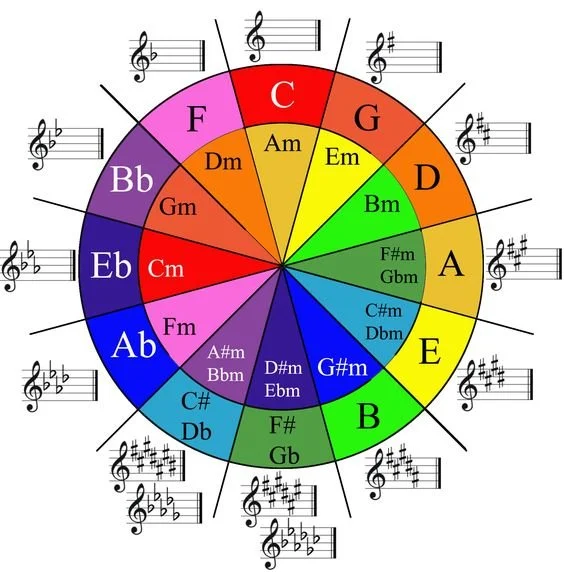There are a lot of ways to show the order of musical notes and how they relate to each other. One way would be a pitch wheel.
The # symbol means “sharp”, and that means “one half step higher”. So C# is one half step higher than C. The b means “flat”, and that means “one half step lower”. So Db is one half step lower than D. The note in between C and D can be called both C# and Db!
As you go clockwise around the wheel, you move up in pitch by half steps. For example, F# is one half step higher than F, and G is one half step higher than F#. Likewise, moving counter-clockwise takes you down in half steps. Bb is one half step lower than C, and A is one half step lower than Bb.
My favorite way to visualize how musical notes are arranged/related is a keyboard. Most of us are familiar with this image, whether we know the note names or not. Here, you can see that the white keys all have letter names, and the black keys in between have sharp or flat names. You can also easily see that C# = Db, D# = Eb, etc. When you get into the technicalities of music theory, sometimes it matters whether you say C# or Db, but for the most part they’re the same thing.
The chart below is called the circle of fifths. A “fifth” is an interval—it’s a specific name for the distance between two notes. G is a fifth above C. C is a fifth above F. F is a fifth above Bb… and so on!
The circle of fifths shows us chords that are closely related. For example, if you start with C, you’ll notice that it sounds good with the chords to the left and right (F and G). C - F - G is a great chord progression! You can do the same thing starting anywhere on the circle of fifths. A likes to be played with the chords to its left and right, D and E. A - D - E is also a great progression!
Here is a more complete version of the circle of fifths. It shows you the key signature and relative minor of each key.



